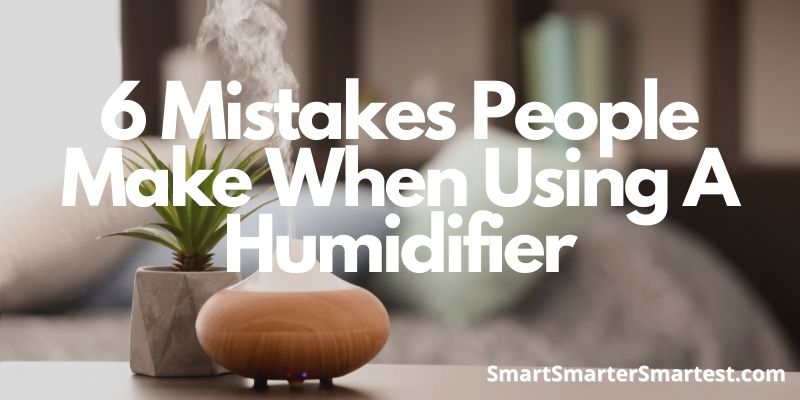As the temperature lessens and as the weather becomes colder, the air becomes more and more dry. To prevent your throat and nasal passages from becoming too dry, and leading to you getting a cold, it’s important to use a humidifier. But, there are six mistakes that people often make when using a humidifier. By being aware of these mistakes, and not making them, you will be able to have a much easier humidification experience!

Mistake 01: Never Dumping Water Out Of The Humidifier
Right after you are finished using the humidifier, dump the left over water out. Don’t wait more than one-day to do this either. If possible, just do it immediately and be done with the process.
The reason you need to do this is because, if water sits in the humidifier for too long, bacteria can begin to breed along the water’s surface. If bacteria begin to breed within the water, then this means that the humidity coming out of the humidifier will be filled with bacteria, which you will then be inhaling.
Needless to say, that isn’t something you want.
Mistake 02: Never Cleaning Out The Humidifier
Every humidifier must be cleaned on a regular basis. Usually, this is quite easy to do, and the manufacturer will often include instructions for performing this process. But, it’s still somewhat easy to forget.
Without cleaning the humidifier – specifically, the moisture tank and the filters that the humidifier uses – mold and mildew can begin to form within the spaces of the humidifier. Once this happens, the humidifier will begin releasing mold and mildew particles into your air, which you should not be breathing in – this is especially true if the air is very dry.
Mistake 03: Choosing Not To Follow The Manufacturer’s Cleaning Instructions
As mentioned in the previous section, most humidifiers come with instructions on how to clean them. But, these instructions aren’t just “suggestions”, they’re guidelines. By not following these instructions, and doing something completely different, you could damage the humidifier or fail to prevent mold and mildew from growing.
Since this is the case, take the time to read through the manufacturer’s instructions. Take note of what has been written, and follow those instructions exactly. By doing this, you will be able to prevent the growth of mold and mildew, which allows your humidifier to last for a long time without any issues.
Mistake 04: Using Tap Water When You Shouldn’t
Many humidifiers can use tap water, especially if that tap water is clean. But, there are some humidifiers that can’t use tap water, due to the particles within the tap water and the ways in which that affects the humidity coming out of the tap water.
Make sure you know whether or not your humidifier can work with regular tap water. If it can, then you’re good. If it can’t, though, then you need to learn what kind of water the humidifier will work with, and then you need to get that water.
More often than not, when you use tap water in a humidifier that doesn’t support it, it will leave behind mineral deposits. If these mineral deposits are left untreated, bacteria will begin to grow, lessening the quality of the humidity coming out of the humidifier by a significant amount.
Mistake 05: Not Paying Attention To The Humidity Levels In Your Home
At any point in time, there is a certain amount of humidity within the spaces of your home. If there is too much humidity, then your health suffers. If there is too little humidity, then your health suffers. There needs to be just enough humidity in your home, and no more than that.
If you aren’t paying attention to the humidity levels in your home, then you may end up producing too much, or too little, humidity. But, if you are paying attention to the humidity levels in your home – using a humidistat is a good choice – then you can produce just enough humidity for your needs.
As a general rule, make sure there is no more than 60% humidity in the summer, and no less than 25% to 40% in the winter.
Mistake 06: Producing Too Much/Too Little Humidity
If there is too much humidity in your home, then allergic symptoms will become much worse. If there is too little humidity, though, then your nasal and throat passages will become too dry, which can lead to a sore throat, cough, and cold. Because of this, make sure that you are producing the right amount of humidity, and no more/no less than what’s needed.


